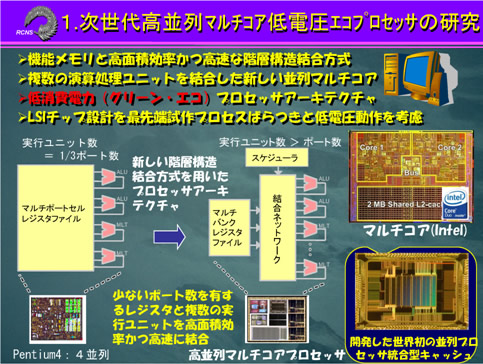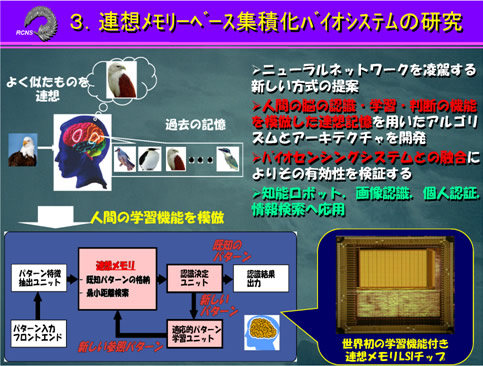
Functional-memories -base intelligent LSI architectures and sensing systems
In order to realize memory-based and intelligent information-processing systems, research focuses on multi-port memories, associative memories, memory-based learning as well as system architectures with visual recognition and learning capability. Especially we are exploring architecture and circuit technologies for LSIs, which realize real-time motion-picture processing. We are also developing systems for flexible and intelligent information-processing based on reconfigurable logic-in-memory architecture approaches and its application to bio-sensing systems.
Subject of Research
Massive-Parallel Memory-Embedded SIMD Matrix Processing (Fig.1)
In this project, we investigate a novel concept of massive-parallel, memory-embedded SIMD (Single Instruction Multiple Multi Data Stream) multimedia processors for achieving highly-parallel processing with low power consumption. The novel SIMD concept relies on many small processing elements with a bit-serial and word-parallel mode of operation, which are directly connected to SRAM arrays. Embedding of Content Addressable Memory (CAM) in the SIMD matrix is also studied to further improve the overall processing performance.
Digital Real-Time Moving-Picture Segmentation and Object Tracking (Fig.2)
Image segmentation is the extraction process of all objects from natural input images and is the necessary first step of object-oriented intelligent image processing, such as object recognition or object tracking. The aim of our project is to develop high-speed, high-density image segmentation/extraction algorithms and architectures for gray-scale/color image segmentation of real-time moving-pictures. In this way we will enable vision-based intelligent processing.
Associative Memory-Based Systems with Recognition and Learning Capability (Fig.3)
Pattern recognition and learning are basic functions, which are needed to build artificial systems with capabilities similar to the human brain. The effective implementation in integrated circuits is therefore of great technical importance. The traditional neural network approach emphasizes the role of the processing elements (neurons) and their interconnection network, but neglects sufficient exploitation of the third powerful system-component, which is the memory. Therefore a memory-based flexible system architecture has been studied in order to realize intelligent data processing such as feature extraction, rough judgment, and analogical inference which an usually done in the human brain. In this project, the fundamental study of associative memory-based, flexible system architecture will be carried out by a broad research ranging from algorithm and system to integrated circuit design.
Message to prospective students
All students in our laboratory design and fabricate LSI and FPGA systems by themselves. They usually acquire the complex and broad knowledge, ranging from semiconductor devices to the socially relevant application systems, in a short time through the collaboration with experienced colleagues. Active interaction with supervisors and senior graduate students enables them to develop the power of opening up a new world. Foreign students who wish to study LSIs are welcome and should feel free to contact us.

Fig.1 Massive-Parallel Memory-Embedded SIMD Matrix Processing

Fig.2 Prototype System for Digital Real-Time Moving-Picture Segmentation and Object Tracking.

Fig.3 Associative Memory-Based Systems with Recognition and Learning Capability.




